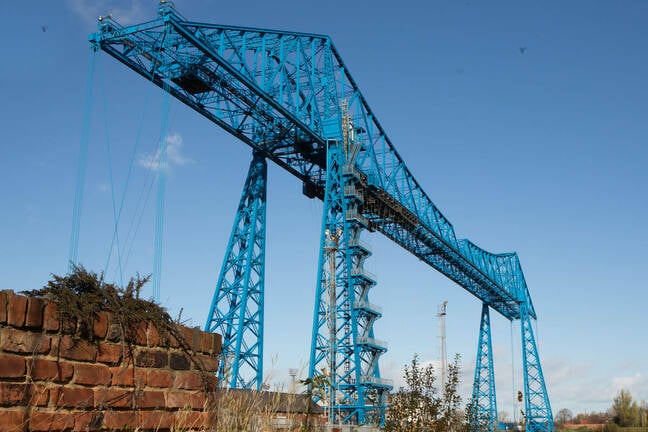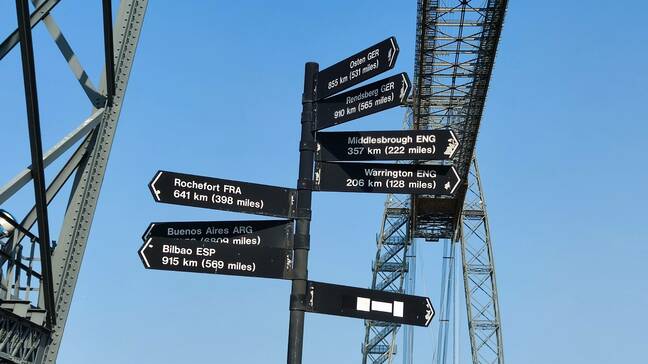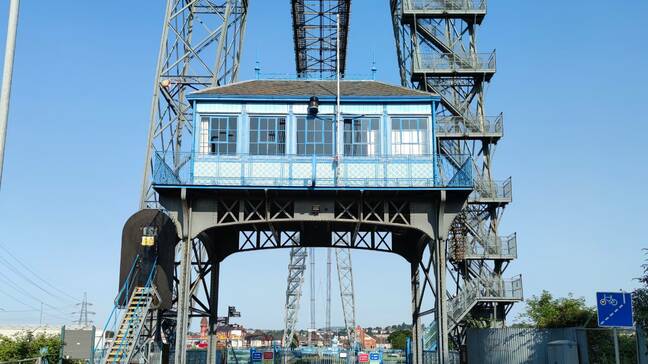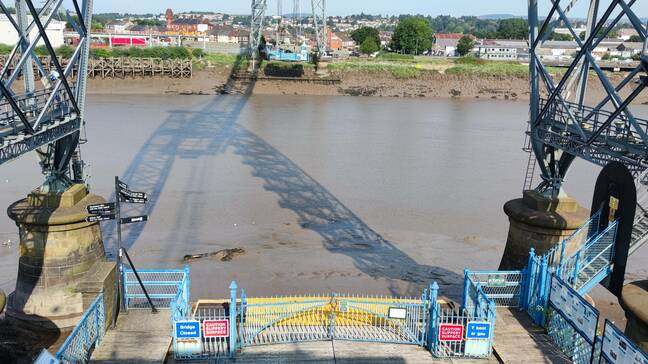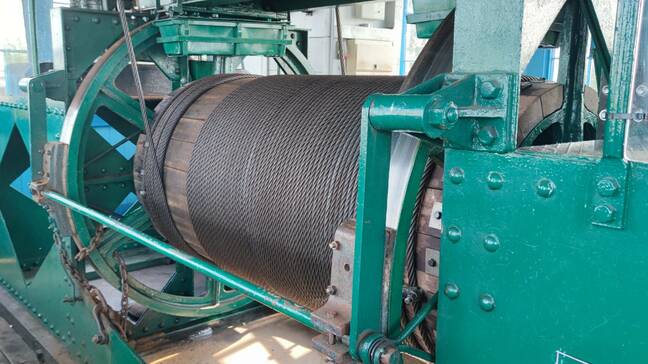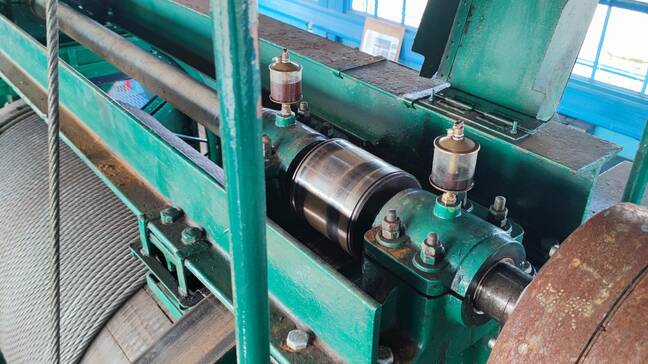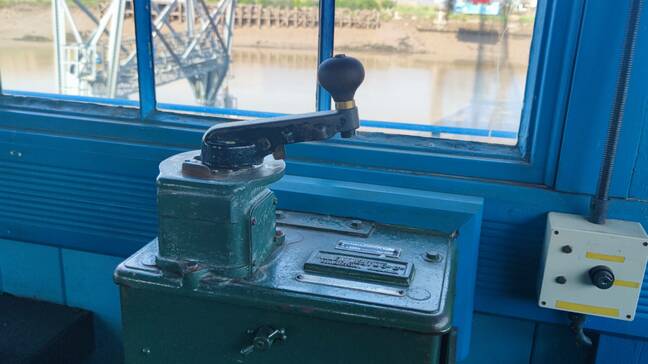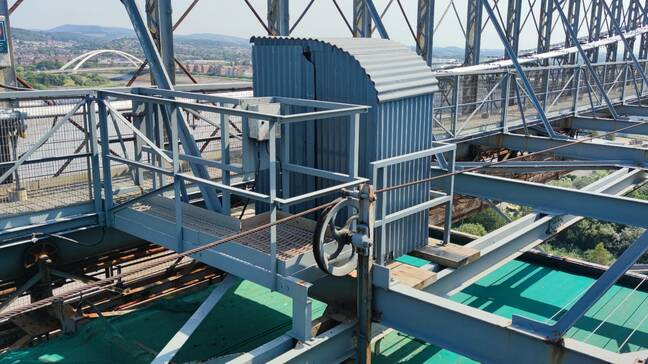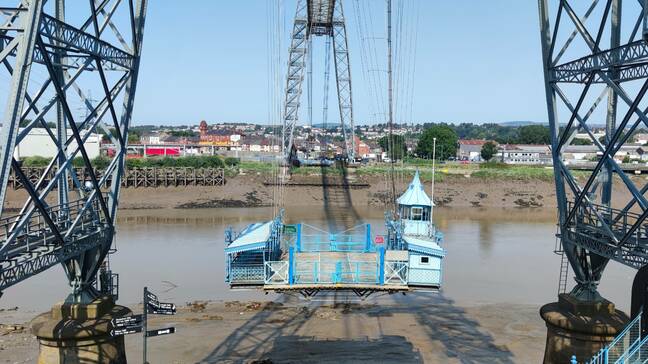This article is more than 1 year old
Is it a bridge? Is it a ferry? No, it's the Newport Transporter
Industrial elegance on the Usk
Geek's Guide to Britain Transporter bridges enjoyed only a rather brief period of popularity as the preferred way to get people and stuff across rivers. The first to be built was the Vizcaya Bridge over the River Nervion between Las Arenas and Portugalete in Spain, in 1893. The last one, crossing the River Mersey at Warrington, was built just 22 years later in 1915.
Since that date, the only transporter bridge built I've come across has been the 1998 Royal Victoria Dock Bridge in London, but though this was designed to take a glass transporter cabin, that aspect of the project was never actually executed.
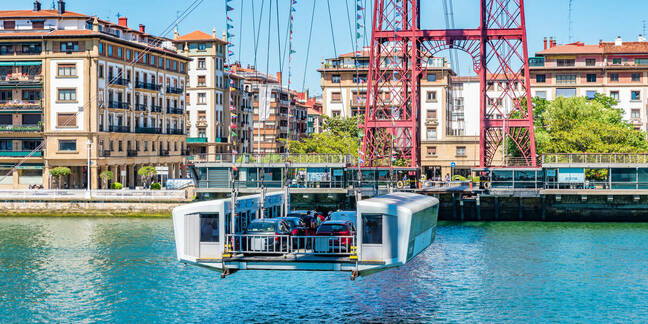
Puente Colgante is the oldest known transporter bridge: pictured is the gondola of the Vizcaya Bridge in Biscay province, Spain. It was designed by Frenchman Ferdinand Joseph Arnodin, who co-designed the Newport bridge... Pic: Takashi Images/Shutterstock
The reason for that short period of popularity is not hard to fathom: It was the brief window when technology was up to the job of building them, sailing ships needed them and road traffic had not yet begun the inexorable increase in volume to the point where not offering a continuous flow of vehicles became a hindrance. Still, transporters were an elegant engineering solution to a specific problem and have left a legacy of graceful, interesting, and in a few cases, still operational, structures.
The UK is currently home to three surviving transporter bridges. The Warrington bridge over the River Mersey was built in 1915 but has been out of regular use since the mid-1960s and is now in a very sad state of repair. Looking at it today it's difficult not to think that sometime soon it will end up in the Mersey rather than spanning it.
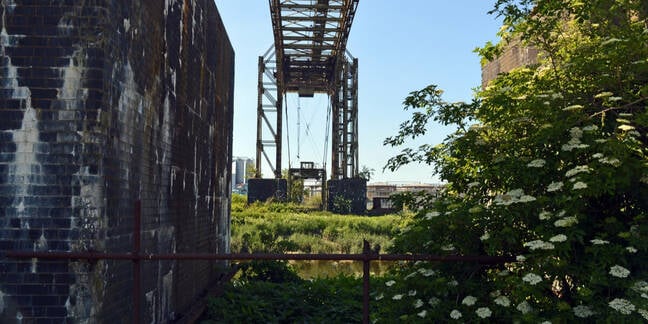
The Warrington transporter bridge, aka the "Crosfield" transporter bridge, was built to link the two halves of the Crosfield factory site which lie on either side of a loop in the River Mersey
The second is the Tees Transporter Bridge in Middlesbrough, which opened in 1911 and was in daily use until a safety inspection in August 2019 labeled it a safety hazard. Remedial works are planned amid rumours in the local press of mismanagement of the structure by Middlesbrough Council.
The transporter bridge in the small Welsh city of Newport is also currently closed to traffic, but its future is rather more rosy, thanks to the fact that earlier this year Newport City Council was granted £8.75m by the Heritage Lottery Fund to overhaul the bridge and build a new visitors centre. It's only closed because the work is about to commence, not because using it risks life and limb.
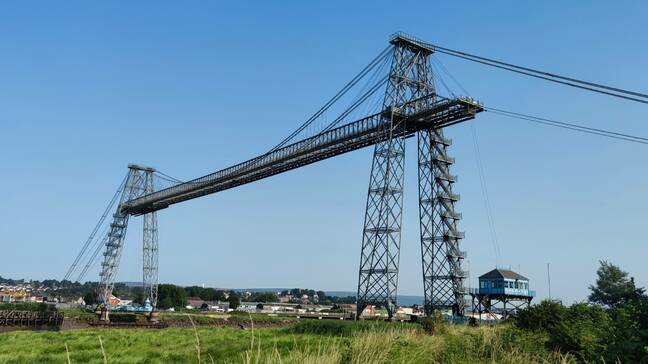
'A giant, with the grace of Apollo and the strength of Hercules': A sound description of the Newport Transporter
The need to provide a second crossing of the River Usk at Newport (the first stone bridge had been built in 1880 next to Newport Castle, replacing a wooden structure first built in the twelfth century) was due to the establishment of the Lysaght Orb iron and steelworks on the eastern bank of the Usk in 1898. This was part of the pell-mell expansion of Newport during the Industrial Revolution as coal and iron poured through the town (it was made a city in 2002) from the Welsh valleys to the north. The impact on the area can be illustrated on one simple set of numbers: In 1800 the population of Newport was around 1,000. By 1901 it stood at 67,000.
As most of the workers lived in the expanding southern areas of Newport proper on the western or Pillgwenlly side of the river, a direct connection that did not involve a round trip of several miles to use the town centre bridge was clearly desirable. Even after a widening in 1866 the town centre bridge was becoming seriously congested. A direct link would also remove commuting workers from the temptations of walking past the town's various public houses, apparently a major concern for the managers of the Lysaght plant.
The task of finding a solution to the problem fell to Newport's Borough Engineer, Robert Haynes. Building a conventional fixed bridge was out of the question. To build one high enough to allow fully rigged sailing ships upstream to get to the town centre docks would have involved building unfeasibly long approached ramps on the low banks on either side of the river.
Some sort of swing bridge was out of the question because the Usk was too narrow to accommodate the central island, which would be required. For similar reasons, a lift-bridge like the Tower Bridge in London was ruled out by Haynes. The necessary stone footings for the towers would extend too far into the channel.
A ferry wasn't the answer either. On its lower reaches, the Usk is not only narrow but home to a ferocious tidal bore and one of the widest tidal ranges in the world. This made using a ferry to cross the river a perilous undertaking. In January 1897 a rowboat ferry was making the crossing when a tug boat called The Albatross sped past, heading upstream, and swamped the ferry – which was already overburdened. In the panic, the ferry capsized and despite the efforts of the tug boat crew, seven of the 16 men on the ferry perished in the icy waters.
Construction work
A transporter bridge was the obvious answer. It would pose no impediment to sailing ships and would be faster – on average the Newport bridge gondola makes four round trips every hour carrying up to six cars and 120 people – and safer than a ferry, though since initially a simple chain was all that stopped people and vehicles falling off the gondola into the Usk, one has to ask how far up the agenda safety actually was. Full gates were added to either end of the gondola soon after it opened for business. It is a testament to the soundness of the design that operation only needed to be suspended if winds exceeded gale-force 6 (25–31 mph or 39-49kph).
Haynes thought the best man for the job of designing the new bridge was Frenchman Ferdinand Joseph Arnodin, who designed nine of the 18 transporter bridges known to have been built including the first, the Vizcaya Bridge. Not everyone agreed with such a new-fangled design, so Haynes dragged a collection of Newport's city fathers to meet Arnodin at his transporter bridge in Rouen (sadly destroyed in 1940 by the retreating French army to slow the German advance). The junket was a success and Haynes and Arnodin were appointed joint engineers for the Newport bridge.
At this juncture, it is worth saying that though Arnodin was the father of the transporter bridge, the basic idea was homegrown here in Blighty. The first recorded proposal for a modern vehicle carrying structure was made by one Charles Smith of Hartlepool who in 1873 published a proposal to cross the Tees at Middlesbrough with a transporter in the journal Engineering. His design is remarkably similar to the eventual 1911 transporter.
The Newport bridge was Arnodin's last (a planned transported in Bordeaux was never completed) and in terms of grace, economy and purity of design it is perhaps his best, though Haynes may have played a part.
The firm of Alfred Thorne of Westminster was contracted to build the bridge in 1902 and it was opened by Godfrey Charles Morgan, 1st Viscount Tredegar, on September 12th, 1906. The cost of construction was some £98,000 – or just over £12m in modern terms – and involved some 1,400 tonnes of steel. Upon opening, Alderman Canning described it as "a giant, with the grace of Apollo and the strength of Hercules."
The most challenging part of the construction was the footings for the two steel lattice towers which are supported by eight 20ft (6m) diameter stone columns with steel shoes. To build them, airtight chambers were excavated and kept at a higher pressure (2.5 atmospheres or 36.7psi) than the outside.
At the end of each day, the pressure in the caissons was reduced to allow the steel shoe to gradually sink. The foundations of the eastern shore columns go down to a depth of 86ft (26m), those on the western shore to 78ft (24m). This was a not wholly dissimilar construction system to that used to build the piers for the Brooklyn Bridge in 1870 and was apparently the first time it was used in Great Britain.
A decade of glory
The Newport Transporter enjoyed quite a short heyday. Newport's docks quickly expanded downstream of the bridge and with the creation of the Alexandra Docks and the South Lock that gave shipping direct access to the Bristol Channel, use of the Town Dock declined rapidly to the point where it was filled in completely in 1930.
The decline in sail power also played a part. A mere decade after it opened, the justification for a transporter bridge rather than a lower, fixed bridge had been greatly reduced.
The opening of the four-lane George Street Bridge in 1964 reduced traffic greatly but it was the opening of the City Bridge in 2004 – which today carries the A48 over the Usk – only a little more than half a mile upstream that really drove the nail into the coffin, reducing traffic over the Transporter by 80 per cent. Incidentally, the record for the most cars carried in a day is 860, when a traffic accident closed the A48 bridge.
The Transporter has nevertheless soldiered on, closing in 1985 due to safety concerns only to be reopened in 1995 following a £3m refurbishment.
Another closure followed in 2008 when another £1.3m needed to be spent, though this time the closure was shorter, reopening in July 2010. The bridge was again closed to traffic in February 2011 for maintenance but reopened on 4 June the same year.Following its most recent closure, the bridge is scheduled to reopen in the spring of 2023.
Since 2012 the bridge has been managed by Newport's Museums and Heritage Service rather than Highways and Transport, underlining the Transporter's significance as a heritage feature rather than a necessary way of getting people across the Usk.
- Vaccine dreams: A trip to Oxford to see a biscuit tin, some bed pans and ChAdOx1 nCov-19
- Western Approaches Museum: WRENs, wargames, and victory in the Atlantic
- The Eigiau Dam Disaster: Deluges and deceit at the dawn of hydroelectric power
- The Wight stuff: Marconi and the island, when working remotely on wireless comms meant something very different
The Transporter achieved a certain degree of fame in 1959 when it featured in the crime drama Tiger Bay with Sir John Mills and his daughter Hayley. In 1981 the structure was listed Grade II and subsequently elevated to Grade I after the 1995 reopening in recognition of its historical and technical significance.
The staff at the Newport Transporter like to call their bridge the Ferrari of transporter bridges, thanks to it being the tallest, having the longest span (if not being the longest overall), being the fastest and having a toilet. A toilet? Indeed. Midway across the truss is a corrugated iron outhouse so that maintenance workers and pedestrians could relieve themselves without having to descend to ground level. The temptation to avoid pulling the chain while the gondola was passing below must have been very hard to resist.
There's certainly no doubting the impressive nature of the structure. The two towers stand 242ft (73.7m) tall while the girder truss that links them is 774.3ft (236m) long. The 35-ton gondola hangs 164ft (50m) below the truss from a network of sixteen steel cables. Climbing to the truss is a relatively simple operation because unlike most transporter bridges the Newport bridge was built with a stairway in one pylon on each side of the river. Getting to the top of any of the other Arnodin-designed bridges involves a backside-tightening ladder climb.
The ease of access to the truss walkways wasn't just to make life easier for maintenance staff and visiting Register hacks. The walkways in the truss carried foot traffic across the river right up until the most recent closure. There can be few more impressive commutes though anyone making the crossing – which involves 278 steps on each side – on a cold and wet South Wales morning would probably accuse me of over romanticising.
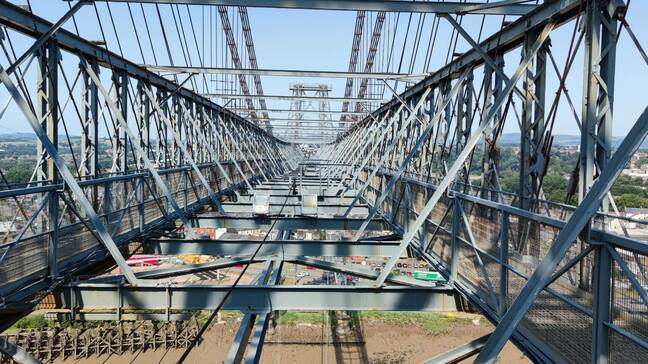
View across the high level truss along which the traveller moves. Foot traffic used the walkways on either side
The gondola is moved back and forth by two 35bhp (26.1kW) electric motors in the eastern control room. These engage via metal-on-metal rollers to turn a teak drum around which the two drive cables are wound. The drum needs replacing every five to six years.
The shorter cable runs up the superstructure to the traveller from which the gondola hangs while the longer cable runs across the boom, around a pulley at the far end and then back to the traveller. This keeps the gondola traveller in tension at all times. The traveller originally ran on phosphor bronze rollers but these have now been replaced with longer-lasting steel ball bearings. A four-speed gearbox lets the engineer increase and reduce speed as the gondola starts and finishes its run.
Just like the control room of the Barton swing bridge and aqueduct, the control room of the Newport Transporter has changed little since it was built other than the installation of a modern set of fuses for the electric motors.
And just like the Barton bridge, controlling it is as much an art as a science, the operating engineer having an acute "feel" for how the gondola travels between each side of the Usk. The gondola covers its 655ft (200m) journey at a rate of 3 meters per second or just under 10ft/s.
With the winding drum running at full speed the vibration can be felt throughout the control box – if something goes awry you would no doubt feel it before you saw or heard anything.
As well as having a good shufti around the control room, I was allowed up onto the gantry that connects the two towers. The spectacular views up and down the Usk river have to be seen to be appreciated and it let me see the degraded condition of the steelwork first hand and the scale of the renovation job about to be undertaken.
It also makes the serpentine and narrow nature of the lower reaches of the Usk more obvious. Navigation to the town centre must have been a fraught undertaking at the height of the Industrial Revolution and it's easy to understand the desire for a bridging solution that didn't further restrict the channel. It was a desire the grand and graceful Newport Transporter fulfilled to perfection.
Newport Transporter Bridge
GPS: 51.57131, -2.98724
Getting there
By car: Newport is just off the M4 motorway which executes a graceful loop around the north of the city. Junctions 24 to 28 are the ones to look out for.
By rail: The Great Western Railway main line from London Paddington to Cardiff Central stops at Newport. The walk from Newport railway station to the western end of the Transporter takes around 30 minutes. To the eastern end, it takes around 1 hour.
The Transporter Bridge is currently best approached from the east side of the Usk where there is ample free parking along Stephenson Street, and a nearby footpath running along the bank of Usk as well as easy access to the outside of the control room. When it reopens the visitors centre will be on the opposite, western side of the river.
Further reading
Newport Transporter Bridge and Industry Along the River by Jan Preece, ISBN 978-1445677859
Transporter Bridges: An Illustrated History by John Hannavy, ISBN 978-1526760388
Further information
If you want to help support the Newport Transporter, you can donate via Friends of Newport Transporter Bridge. ®
